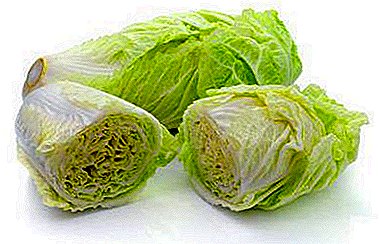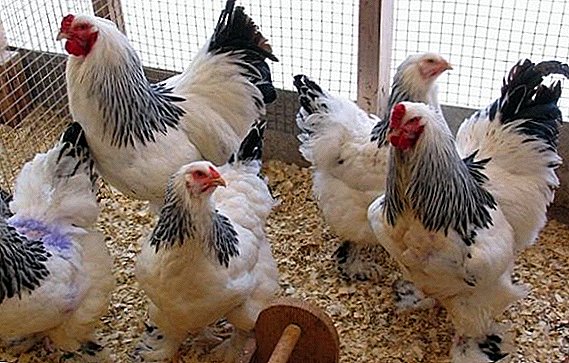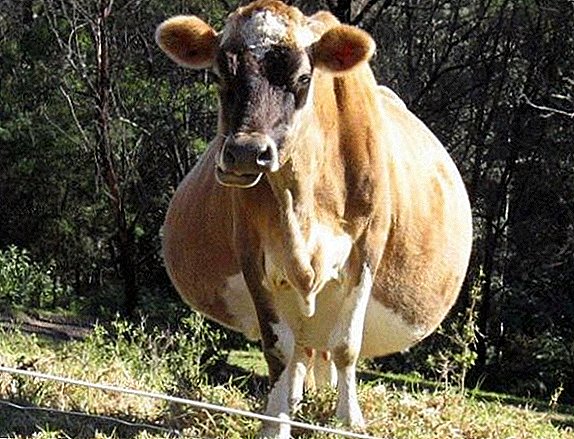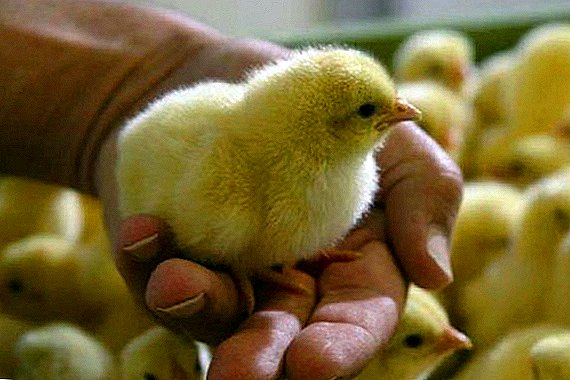 Broiler chickens have a very high body weight, fast weight gain and good taste. This article is devoted to the topic of breeding these chickens - you will find in it instructions on how to feed and feed the birds to achieve the most impressive results, as well as learn about possible mistakes that are often made when raising them.
Broiler chickens have a very high body weight, fast weight gain and good taste. This article is devoted to the topic of breeding these chickens - you will find in it instructions on how to feed and feed the birds to achieve the most impressive results, as well as learn about possible mistakes that are often made when raising them.
How to choose chicks
The key to successful cultivation is the correct selection of young animals that would meet the standards of the hybrid and be able to gain weight properly and in time. 
However, broilers at a young age can be difficult to distinguish from ordinary chickens, so the purchase should be made not from private sellers who can give you a different breed of birds, but in poultry farms.
Did you know? The first broilers were formed by crossing such breeds as white Plymouth (as chickens) and Cornish (as roosters). It happened around the 1930s.
It is necessary to carefully study the appearance of young birds, paying particular attention to their feet. Normally, they should be mobile, straight, should not contain any defects in the form of stains, wounds or bruises.
Try to pinch the chick slightly for its fluff: if you have nothing left on your fingers, then the chick is most likely healthy. 
Next, you should pay attention to the eyes of birds. You can’t take a bird whose eyes are covered with a film - this is a sure sign that they are not healthy and will die soon. Normal eyes should be bright and shiny.
After that, it is worth examining the chicks' chicks Normally, they are pyramid-shaped, smooth, light yellow in color. If you notice deviations in the structure of the beak - it is better not to take such a chicken. There is a high probability that he will not be able to eat normally and die.
Find out what breeds of broilers belong to the best, as well as about the peculiarities of the content of such a breed of broilers like Hubbard.
The best time to buy broilers is the end of May - the beginning of June. Over the summer, the bird will have time to get stronger, gain weight, and if you decide to leave a certain number of adults for brood breeding, you will be able to easily endure the cold season.
At what age is it worth buying chickens
It is best for novice poultry farmers to acquire chicks of two weeks of age - they are already quite strong and, most likely, will be able to survive acclimatization in new conditions without much loss. 
If two weeks old chicks are not available, youngsters can be purchased at a week old.
There will be more problems with it, however, its survival rate is extremely high compared to one-day chicks.
Did you know? Chickens lay eggs only if there is light. Even if it was already time for them to rush, they would not do this if they did not turn on artificial lighting for them or if a the sun will not appear.
It is better not to buy chickens that are less than one week old, since many birds with genetic defects die 6-10 days after their birth, and you will have a very high probability of collecting such ones.
In addition, young chicks rather poorly tolerate the absence of a large source of heat nearby, which normally is an incubator or their immediate mother, which may also prematurely die. 
Rooster or chicken
Since the broiler is still a meat hybrid that carries very few eggs, it doesn’t matter what kind of birds you’re getting for yourself. However, this may be important if in the future you want to independently conduct a full biological cycle of rearing chicks using live rooster and chicken.
To do this, we will understand how to determine which of the chicks is a rooster and who is a chicken.
To determine the sex of a chick, it is necessary to take in the palm so that the head is near the little finger, with the thumb and forefinger to clasp its back, and then look into the cesspool of the feathered to see in it the so-called genital tubercle, which distinguishes roosters from chickens . 
Breeding characteristics
Breeding broilers in general does not differ from breeding other breeds of chickens, however, there are some subtleties. For example, all poultry farmers know that broilers produce quite a lot of waste, but not everyone knows that there is a need to regularly clean their place of residence, otherwise the development of dangerous infections is possible. You can read more about this and other features below.
Content on litter
If you have a separate room where broilers can be kept, it will require some preparations:
- First, treat the walls and floor of the future house with lime to sanitize the room and protect the young from infection.
- Allow the room to air and dry, since broilers need a dry room.
- Cover the floor with oilcloth, on which you will lay 2.5-3 cm litter of sawdust or hay.
- It is necessary to sterilize the drinkers and feeders, prepare and install lighting lamps and a special lamp for heating the young.
- Next, hang in a place convenient for you (preferably not far from the place where the young are located in the largest quantities) a thermometer in order to constantly monitor the temperature inside.
- Finally, put a fence near the door that will prevent the young broilers from escaping from the room - and you can run the chickens inside.

Important! In the first two weeks of life, chickens must be kept at a temperature of 30-32 ° C. Further gradually put down her 1-2 degrees every week until you bring it to 20 ° C.
Content in cells
Broilers react badly to keeping them in a cell, because they need a lot of heat, space and food for normal growth and development, and in a cell it is difficult to achieve this.
If you are not able to identify the youngsters in the room, try to plant the chicks only 6-7 in each cage (1x1x1 meter).
In each cage it is necessary to install a powerful heating and lighting system made of lamps, which must be used at full capacity at night to prevent the death of birds.
It will be useful for you to learn about the features of keeping chickens in cages, how to make cages for broilers with your own hands.
To keep broilers outdoors successfully, the temperature inside each cage should not fall below 27 ° C even at night, so you have to seriously invest in a heating system. 
Each cell must be equipped with a feeder and drinker, which must always be full. This is necessary in order to broilers are constantly growing and gaining weight normally.
It is recommended to place the drinker and the feeder in a cage so that each chicken, if he has a desire, can find a place for himself at the feeder (the ideal location is right in the center of the cage).
The floor of the cells must have a litter that must be changed once every few days in order to avoid the development of various infectious diseases.
Important! The cage should always be under your visual control, so that in the event of the death of one chicken, its peers would not peck and thus catch the disease from which he died.
What and how to feed
Broilers require a special relationship to their own diet - it is only thanks to him and their genetics that they gain such huge weight in a short time. 
Here's how best to feed broilers depending on age:
- 0-5 days - dry millet;
- 5-7 days - dry millet, a small amount of dry food;
- 7-10 days - starter feed is gradually introduced; instead of water, pour fresh dairy whey every 3 days;
- 10-14 days - add to the diet greens in small quantities (onions, nettles, etc.);
- 14-30 days - cottage cheese, ground grain, ground egg shells, various vegetables (cabbage, carrots, boiled potatoes) are introduced;
- 30-60 days - can be completely transferred to animal feed or to give crushed wheat cereal, fish and meat waste brewed in meat broth; keep on giving various boiled vegetables;
- 60-90 days - Replace the crushed porridge with whole grains, enter the legumes in the diet for more active weight gain.
Learn how to feed broiler chickens correctly, how and when to feed chickens to nettles for broilers.
If we talk about the frequency of feedings, then broilers, especially in the first month of their life, need to provide constant access to fresh food and water. Only in this way they will be able to gain the desired weight by the three-month period, after which their meat will lose a significant part of its pleasant organoleptic properties. 
Therefore, try to ensure that your birds always have access to fresh food, preferably even at night.
Vitamin supplements
Broiler supplements, also known as premixes, contain a whole range of different components:
- useful,
- nutritious,
- tonic,
- preventing the development of diseases
- helping birds gain weight.
Among these additives are the following varieties:
- vitamin supplements;
- mineral supplements;
- vitamin and therapeutic supplements;
- vitamin and mineral supplements.

Important! When the birds reach the age of one month, many people are frightened that the bird loses all the fluff, and the feathers still do not have time to grow. Don't worry about it. - for broilers it is absolutely normal.
Depending on your goals, as well as the condition and needs of the birds, a certain supplement may be necessary at a particular moment. For example, a vitamin supplement, including vitamins A, E and D, is given starting from day 5 of broiler life in order to prevent the development of diseases of the osteo-articular apparatus.
It will also be useful for you to find out which diseases of broilers are infectious, and which are non-infectious, why broiler chickens die, than to treat diarrhea in broilers.
All other additives are given according to the situation and may contain the following substances:
- various vitamin complexes (A, B, C, D, E, PP, K);
- trace elements - iodine, iron, selenium, manganese, cobalt, iron, etc .;
- macronutrients - magnesium, sulfur, sodium, potassium, chlorine, etc .;
- various biological active substances - antioxidants, proteins, amino acids, etc .;
- antibacterial drugs - metronidazole, penicillin, tetracycline, etc .;
- fillers - chalk, flour, soy, bran, etc.

Errors in growing broilers
Inattention to the characteristics of broilers often leads to errors that seriously affect the livelihoods of birds.
- The most common mistake when growing broilers - insufficient light and too short day in the first month of life. Many poultry farmers recommend not to turn off the light to chicks at all in the first month of life. In the future, the lack of daylight leads to a decrease in the potential and rate of mass gain by birds, the development of rickets and other pathologies of the bone-joint apparatus.
- The second serious mistake is insufficient attention to the diet. Many owners do not understand that in many respects only due to the specific menu such rapid and productive growth of these birds is possible, and feed them like ordinary chickens. The result is a slowdown in growth processes, the occurrence of diseases and even death.
- A serious mistake is considered and unwillingness to give these hens fortified supplements, or insufficient amounts of them. It is necessary to understand that because broilers are growing too fast and gaining weight, they need much more nutrients than regular chicks. Therefore, be sure to give them at least one fortified supplement, and it is better to add to it another mineral one.
- It is worth remembering also about the possible development of various bacterial complications and pathologies.resulting from the contact of delicate birds with contaminated bedding and / or an infected room. To prevent this, disinfect the house and try changing the feed at least once every 3-4 days.

So, we hope that you have learned all aspects of broiler cultivation that interest you. Breeding meat breeds of chickens is a good business that can bring you and your family not only a solid income, but also a lot of positive emotions. Do your job with love and gratitude, and the reward will not take long!
Feedback from network users














